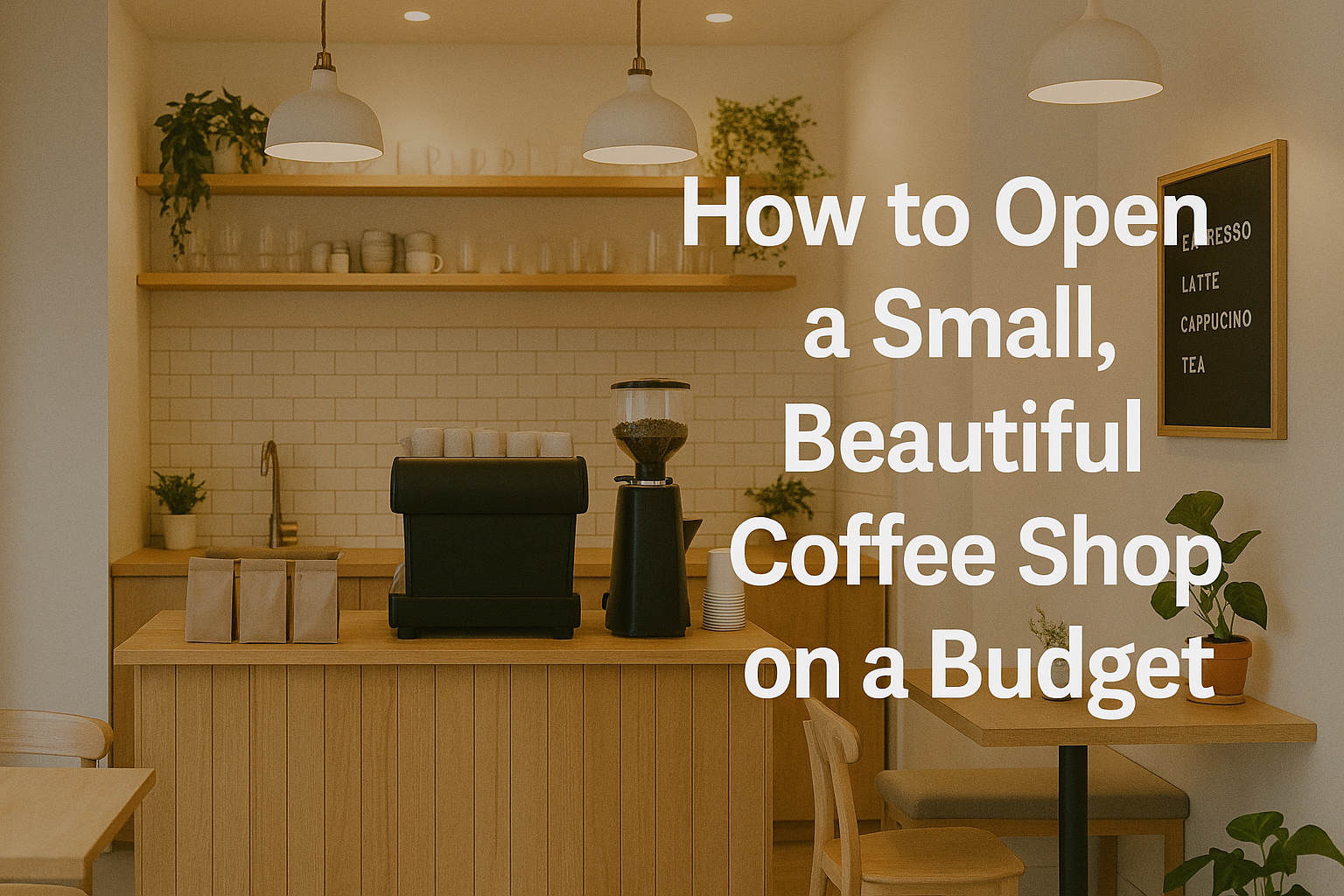Opening a coffee shop is a dream for many baristas and coffee lovers, but the idea of needing thousands of dollars in capital often scares people off. The truth?
You don’t need a massive budget or a downtown location to open something beautiful, welcoming, and profitable.
With careful planning, creativity, and a bit of hustle, you can open a small café that reflects your personality and serves your community — without breaking the bank.
In this guide, you’ll learn how to plan, budget, design, and launch your own small coffee shop step by step, even if you’re starting with limited funds.
Start With a Clear Concept
Before spending a single cent, you need to be crystal clear about your concept. The more focused your idea, the easier it will be to make decisions, reduce costs, and attract loyal customers.
Ask yourself: What kind of café do I want to create? Who is it for? What experience do I want customers to have? Will it be grab-and-go or cozy and sit-down? Will I serve food or focus only on drinks? Will it be specialty-focused or more general?
A well-defined concept saves money because you won’t waste resources on things that don’t match your vision. It also helps you stand out in a crowded market.
Choose a Small Footprint Location
Big spaces mean big costs — more rent, more utilities, more furniture, and more cleaning. A small coffee shop (15–40 m²) can be just as impactful if well designed.
Look for affordable locations such as: Side streets near high foot traffic areas Shared commercial spaces or lobbies Converted garages or shipping containers Small storefronts in residential neighborhoods Pop-up or seasonal setups that can evolve later
Choosing a smaller space forces you to be efficient, and that’s a good thing. Focus on making every square meter work hard.
Negotiate Everything — Especially Rent
Rent is usually your biggest ongoing expense. Negotiate firmly and don’t be afraid to ask for: Reduced rent for the first 3–6 months A rent discount in exchange for doing renovations yourself A short-term lease with option to renew Utility or maintenance cost sharing with the landlord
Landlords often prefer a paying tenant over an empty space, especially if you’re improving their property. Be professional, show your plan, and ask for terms that support your early-stage growth.
Design a Budget-Friendly Floor Plan
You don’t need expensive architects. A simple, functional layout is enough to start. Focus on: A compact but clean bar area Efficient flow from order to pickup A small seating area (if any) with flexible furniture A clear customer path and open sightlines
Use free design tools like SketchUp or Canva to map your layout, or ask help from someone who understands café workflow. Remember, comfort and flow matter more than fancy finishes.
Use Secondhand and Repurposed Materials
Brand-new furniture and fixtures can destroy your budget fast. Instead, get creative with sourcing.
Try: Facebook Marketplace or Craigslist for counters, stools, or fridges Restaurant supply auctions for espresso machines and under-counter equipment Reclaimed wood or pallets for building your bar IKEA hacks for seating, storage, or display pieces Local carpenters for custom work (often cheaper than chains)
Used doesn’t mean ugly — with good cleaning and thoughtful styling, secondhand elements can give your café unique character.
Start with a Lean Equipment List
Don’t over-equip your café before you know your sales volume. Buy only what you absolutely need to serve your core menu.
Basic gear includes: Espresso machine (2-group is usually enough) Grinder(s) for espresso and filter Water filtration system Small fridge or cooler Hand sink and prep sink Scale, tamper, pitchers, and tools Optional: batch brewer or pour-over setup if filter is on your menu
Buy used equipment when possible, but have it tested by a technician. Maintenance costs can kill a budget if you buy something unreliable.
Focus Your Menu
A short, high-quality menu saves you money, simplifies training, and speeds up service. Start with: 5–6 classic espresso drinks (espresso, americano, cappuccino, latte, flat white, mocha) 2–3 cold options (cold brew, iced latte, iced tea) Optional: 1–2 signature drinks (like flavored lattes or seasonal specials)
Offer dairy and 1–2 plant-based milk options. Avoid large food menus at first — instead, partner with a local bakery for pastries or simple snacks.
Your menu should be easy to execute, use minimal ingredients, and deliver great flavor every time.
Handle Permits and Licensing Early
Legal requirements vary by location, but most small cafés need: A business license A food service or health permit An inspected food-safe preparation space A food handler’s certification A fire safety check
Get these done early so you don’t run into delays during opening. Contact your city’s small business office or health department — many offer free guidance or checklists.
Decor on a Budget: Less is More
A beautiful space doesn’t mean expensive furniture or designer finishes. Think cozy, personal, and intentional.
Try: Hanging plants (real or high-quality fake) Soft lighting (warm LEDs, string lights, or lamps) A few pieces of art or photography (your own or local artists’) Neutral or warm-toned paint DIY signage (chalkboards, wood panels, vinyl decals)
Keep walls uncluttered and let textures (wood, ceramics, greenery) bring the space to life. The goal is to feel welcoming — not overdesigned.
Build a Pre-Launch Buzz
Even before opening, you can build an audience and start connecting with your future customers.
Use Instagram to share: Behind-the-scenes of your build-out Your story and why you’re opening Sneak peeks of your drinks Collaborations with local businesses Countdown to opening and soft launch dates
Consider doing a limited soft opening or “friends and family” event. It builds buzz and gives you a chance to test your flow with real customers.
Start Small, Then Scale
In your first few months, focus on: Consistent service and drink quality Listening to customer feedback Learning what sells (and what doesn’t) Tracking your best-selling times and menu items Managing costs — especially staffing, inventory, and waste
Once you’ve built momentum, you can: Add seating or outdoor tables Expand your menu gradually Bring in local retail products or coffee beans Launch delivery or takeaway options Explore loyalty programs or pre-paid coffee cards
Your first version doesn’t have to be perfect — it just has to be real and sustainable.
Be Smart with Staffing
If you’re starting small, you may be the only barista for a while. As you grow, hire slowly and intentionally.
Start by training 1–2 part-time staff who can cover peak hours. Look for people who are reliable, friendly, and teachable — even if they don’t have experience.
Offer clear processes and checklists to make training smooth. When things are systematized, it’s easier to delegate without losing quality.
Track Every Dollar
Keep tight control of your expenses from day one. Track: Daily sales and average ticket size Inventory waste and COGS (cost of goods sold) Labor hours and payroll Rent, utilities, and recurring expenses Unexpected repairs or one-time fees
Use simple tools like Google Sheets or apps like Square, Toast, or QuickBooks. What gets measured gets managed — and smart numbers keep your café alive.
Think Local and Build Community
What makes small cafés special is their ability to connect with people. Focus on creating a space that feels like a part of the neighborhood.
Ways to build community: Collaborate with local artists, musicians, or farmers Leave space for customers to post flyers or announcements Donate coffee or sponsor a local school or sports team Host small events or tastings Use your story to build human connection
People come for the coffee — but they return for the way you make them feel.
Final Thoughts: You Don’t Need Big Money to Start Small
Don’t wait until you have a perfect space, perfect equipment, or a huge budget. Start with what you have. Focus on service, flavor, and experience. Stay lean, stay humble, and stay consistent.
The most beautiful cafés aren’t always the biggest — they’re the ones where the details matter, the coffee tastes great, and the people feel at home.
You’ve got the skills. You’ve got the vision. Now build it, one coffee at a time.

Marcelo Rodrigues is a passionate barista with over 7 years of experience in specialty coffee. He’s worked in top cafés, led barista training sessions, and now shares practical tips to help beginners and coffee lovers improve their skills. Through this blog, Marcel makes the world of coffee more accessible—one cup at a time.

